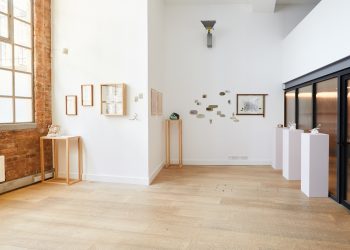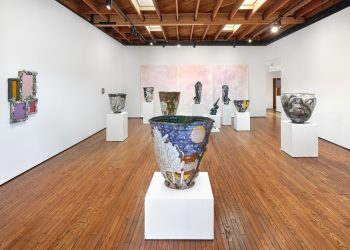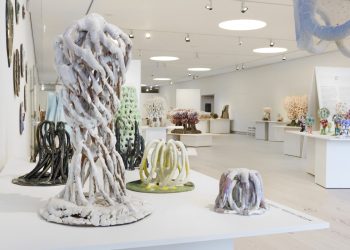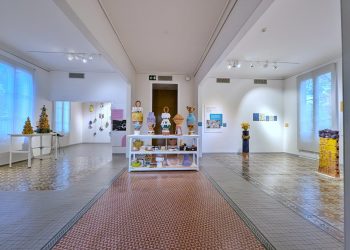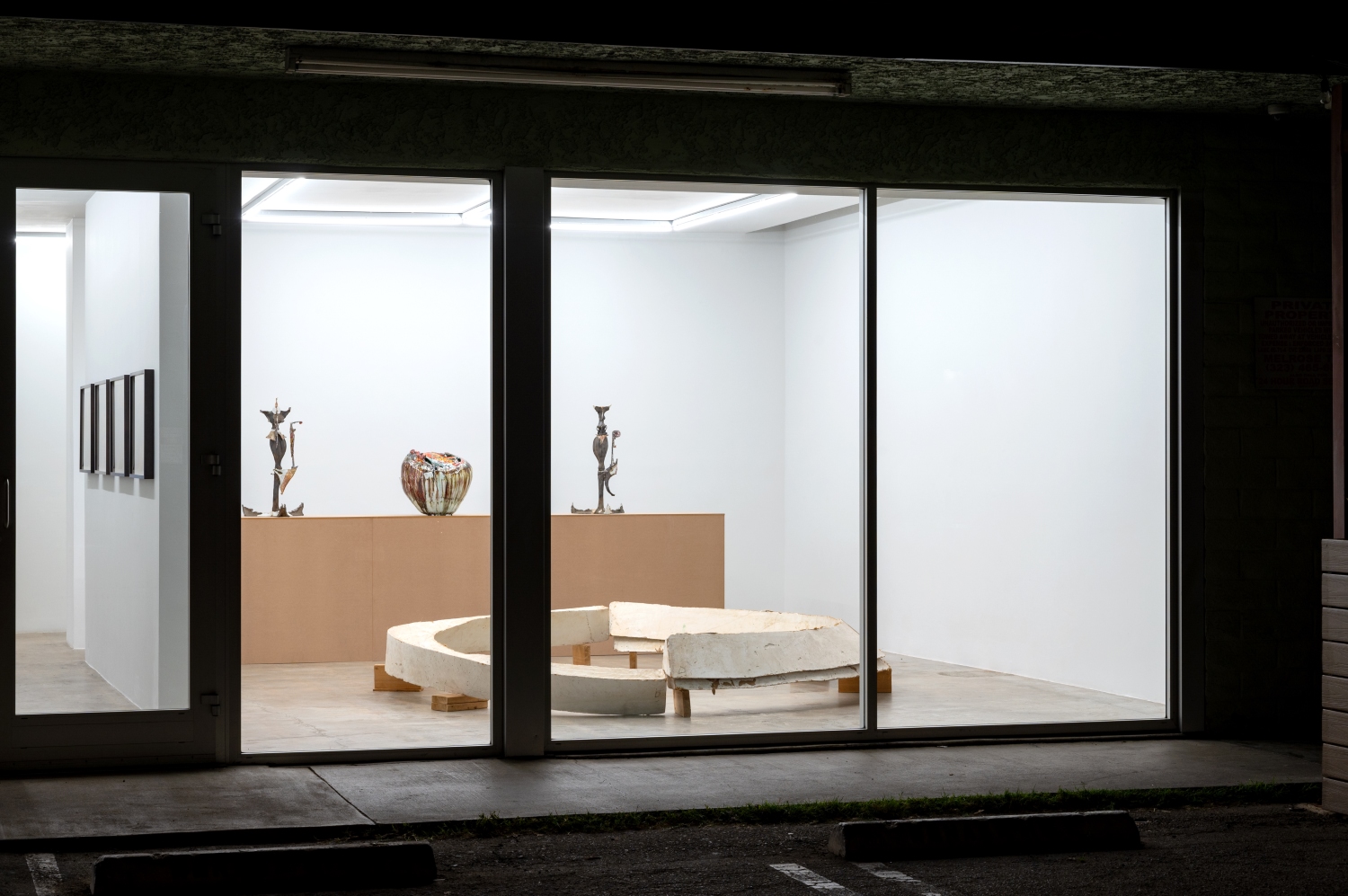
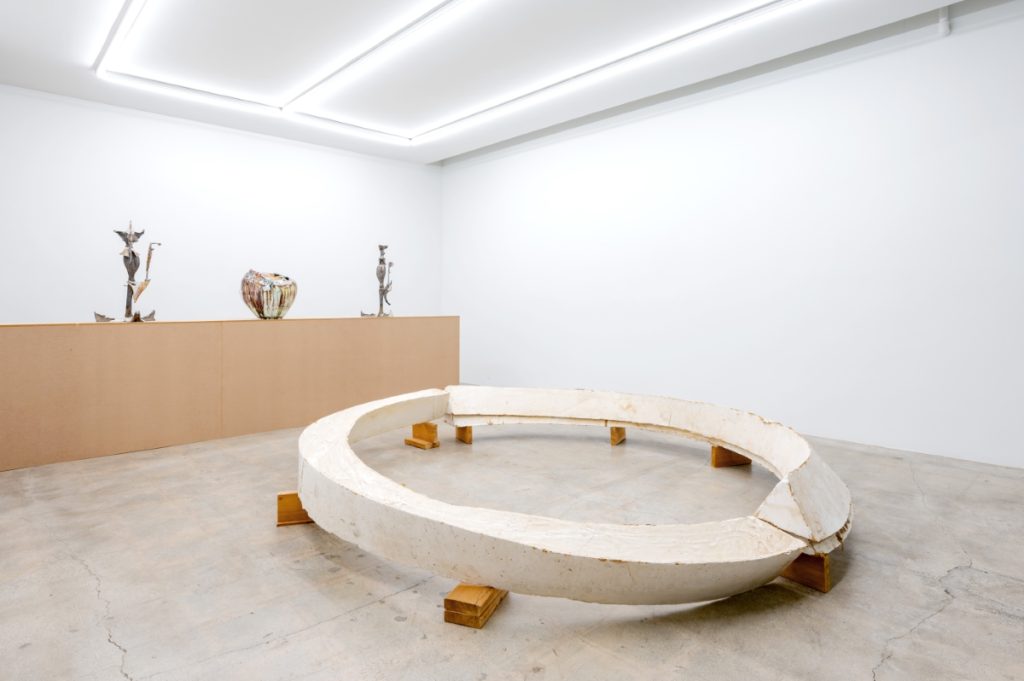
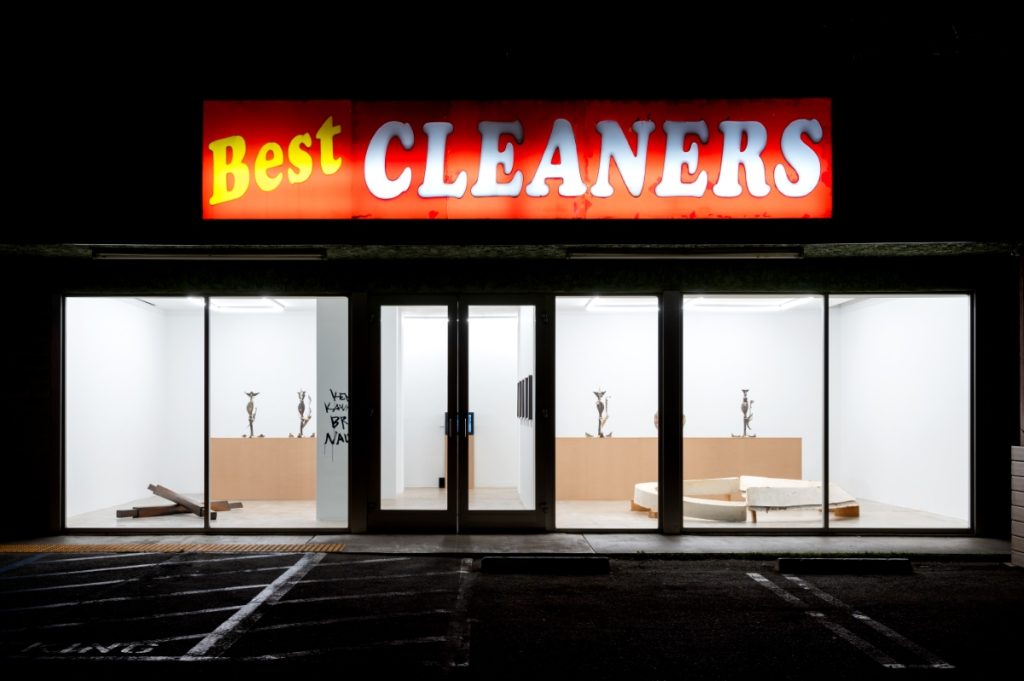
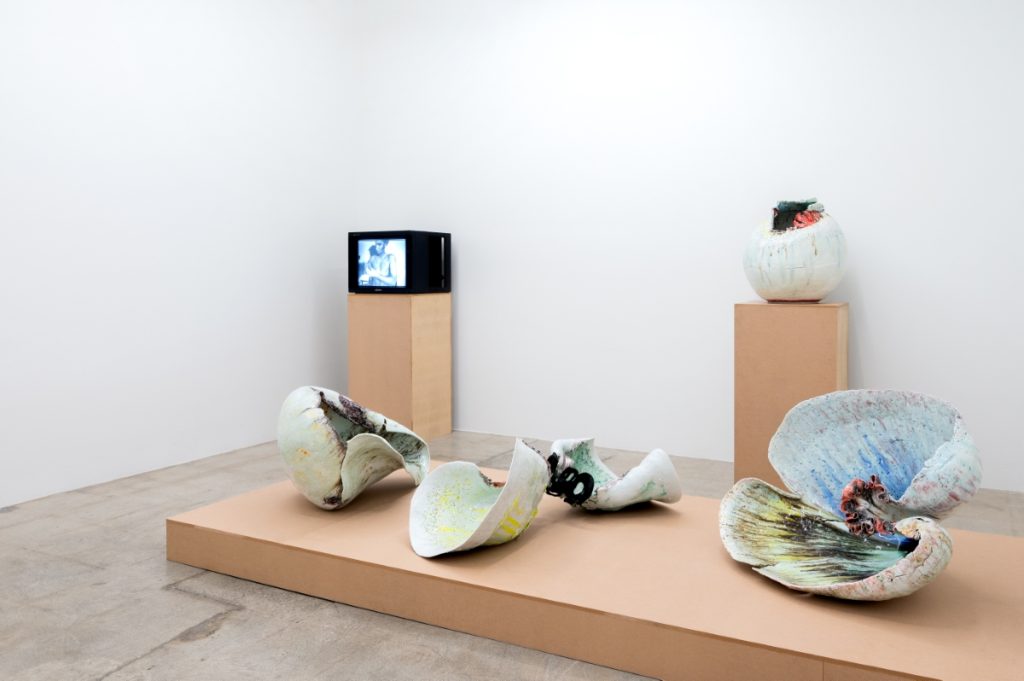

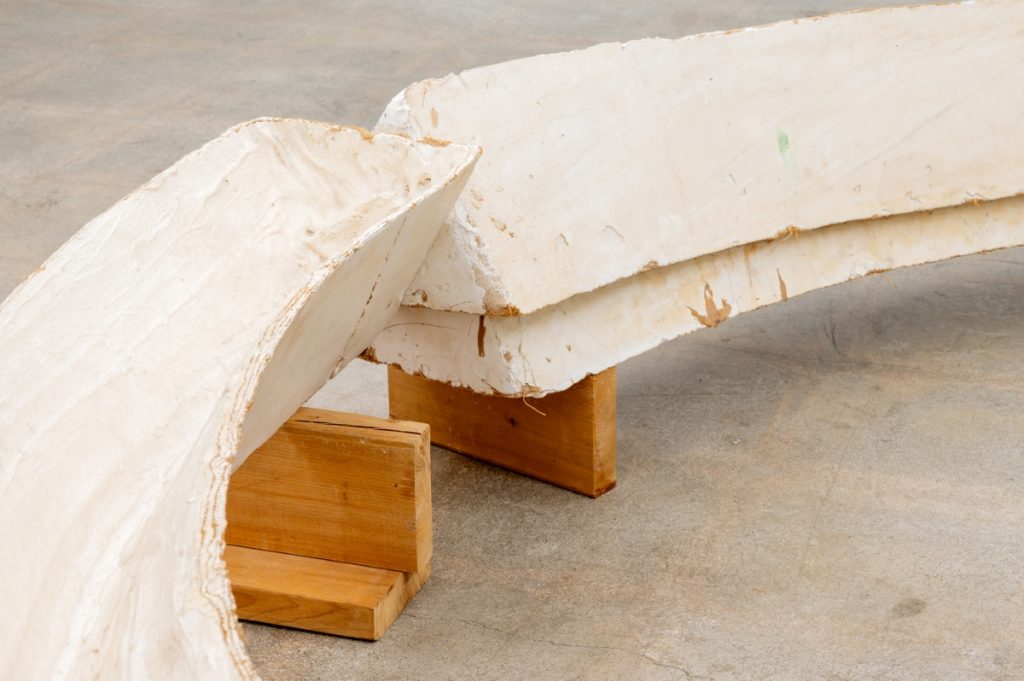
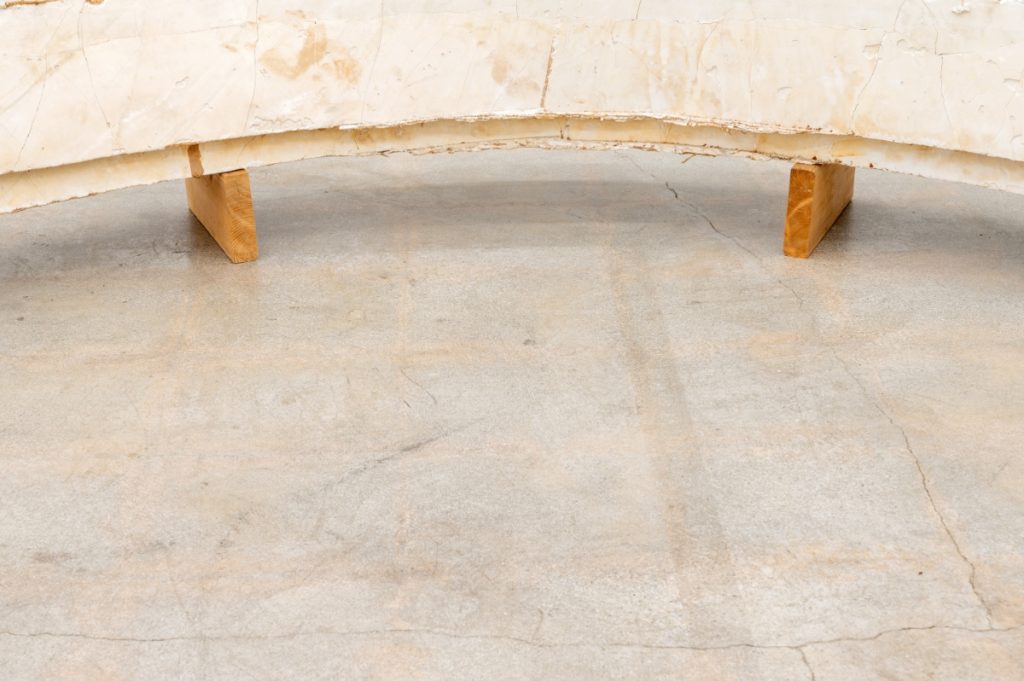
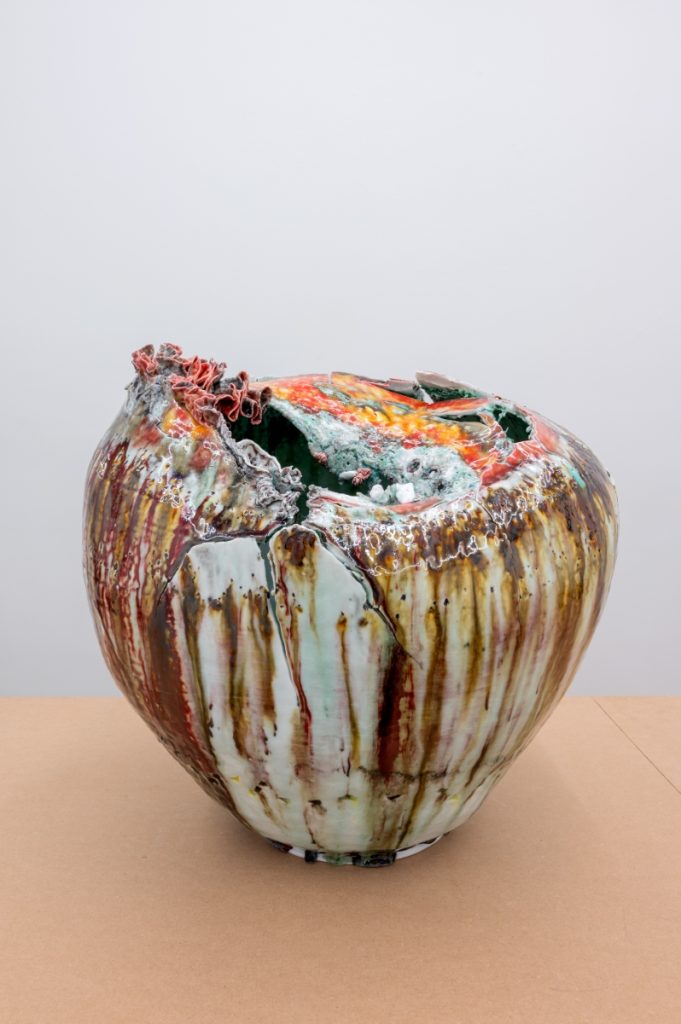
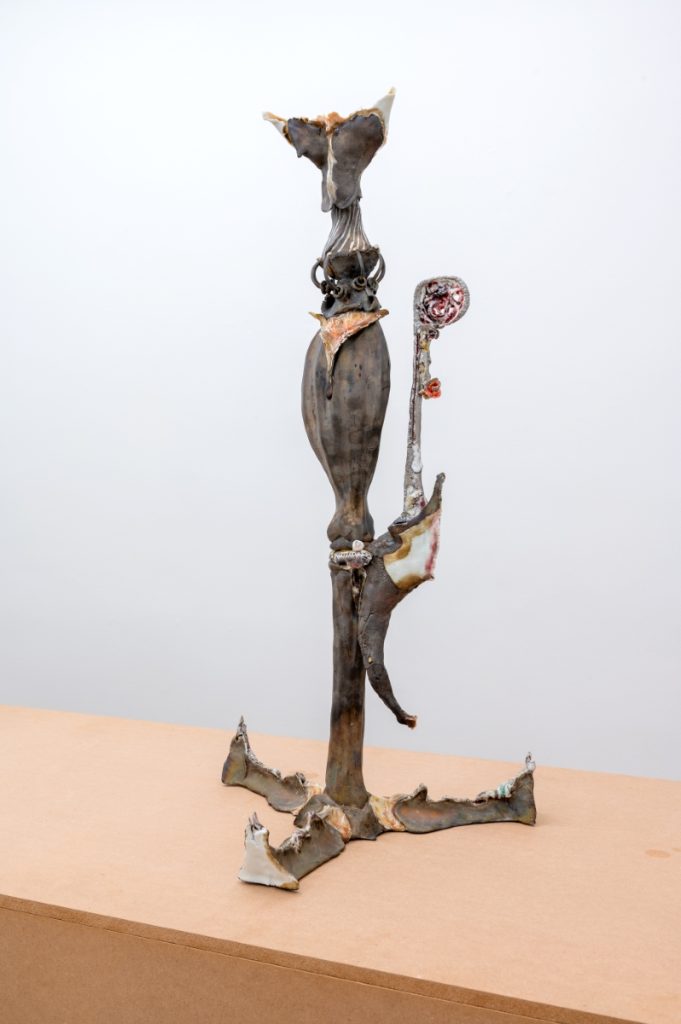
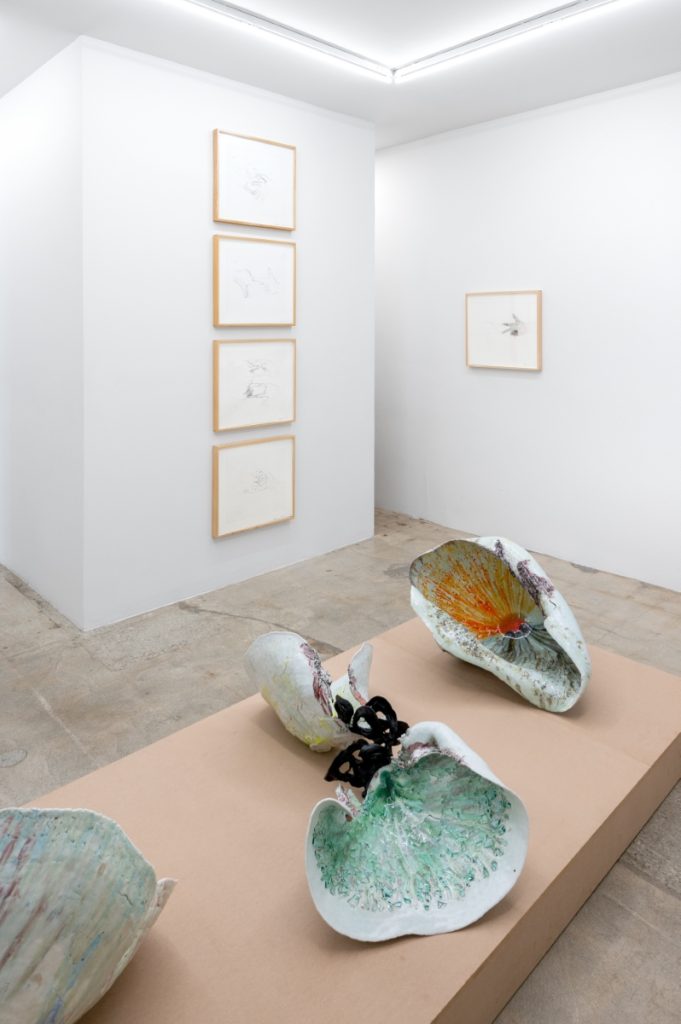

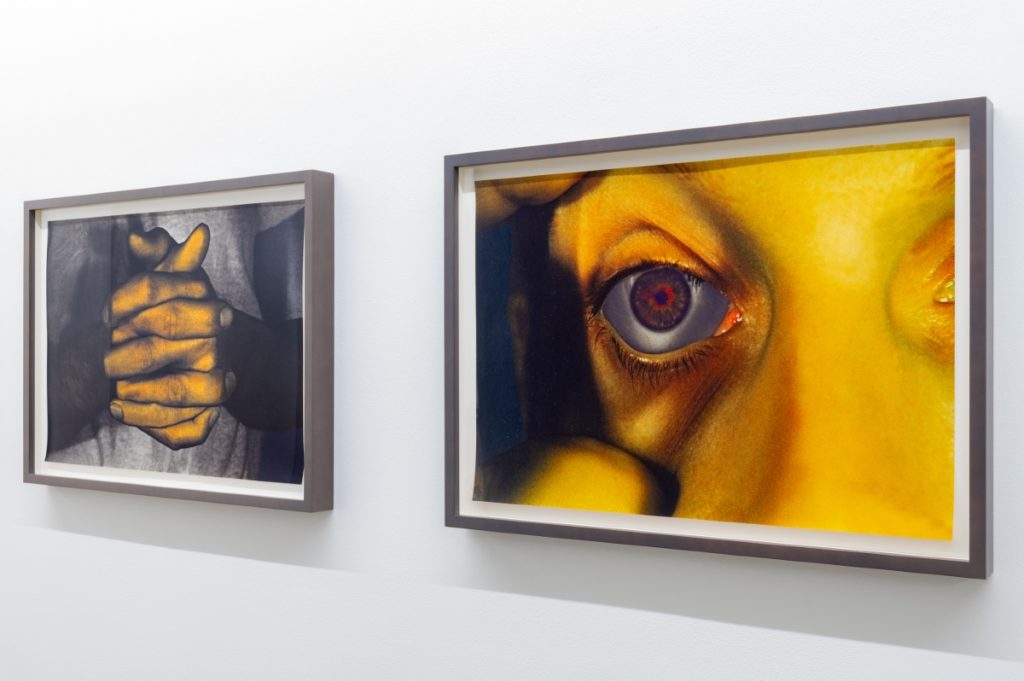
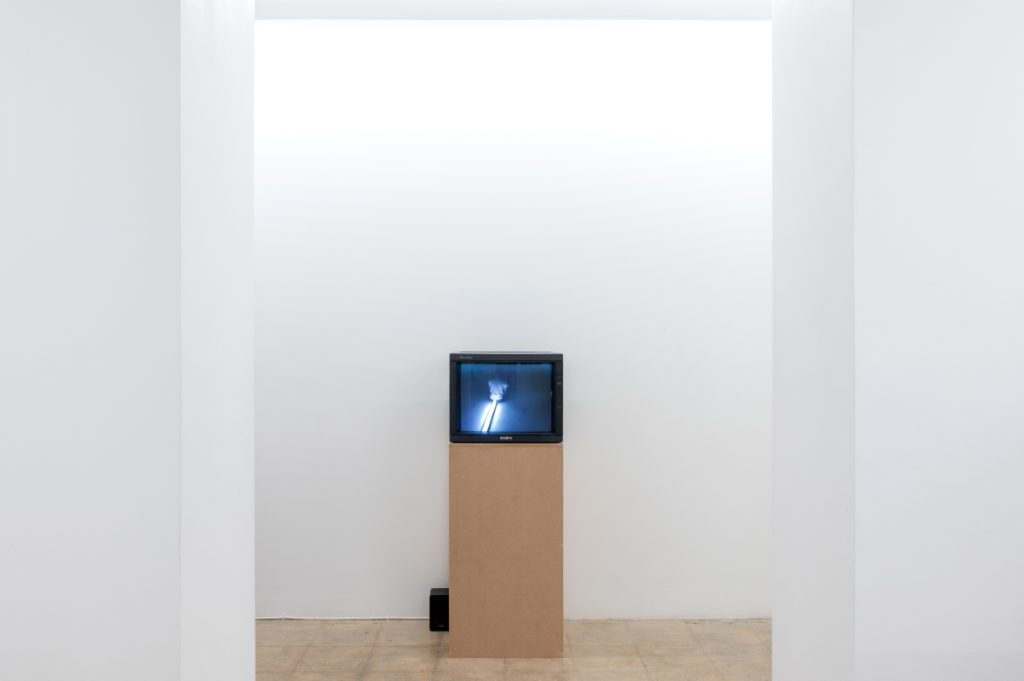
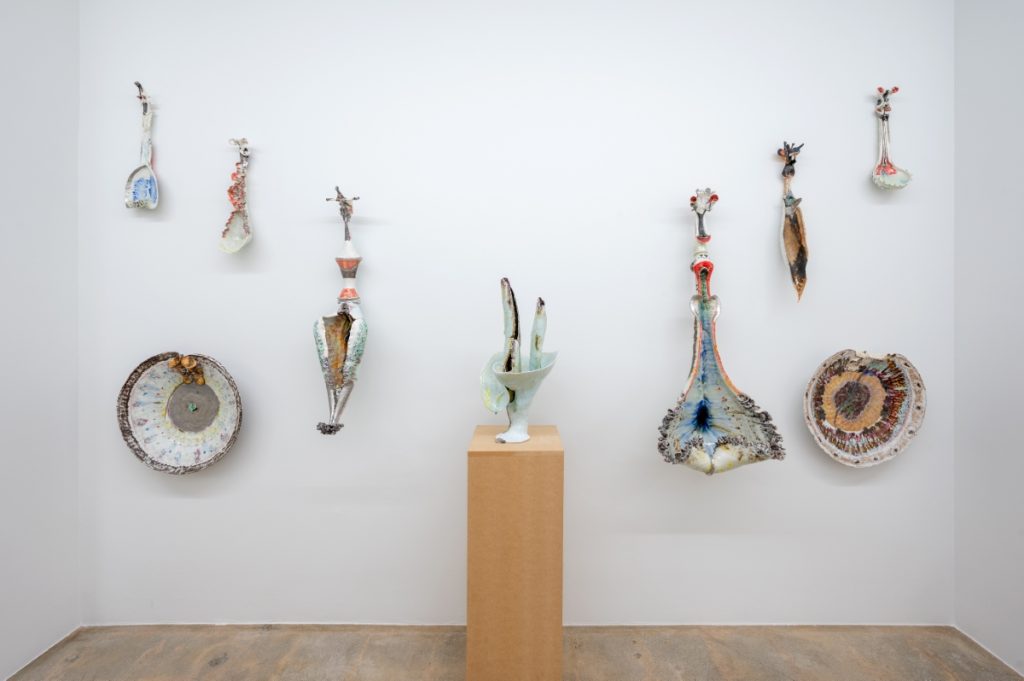
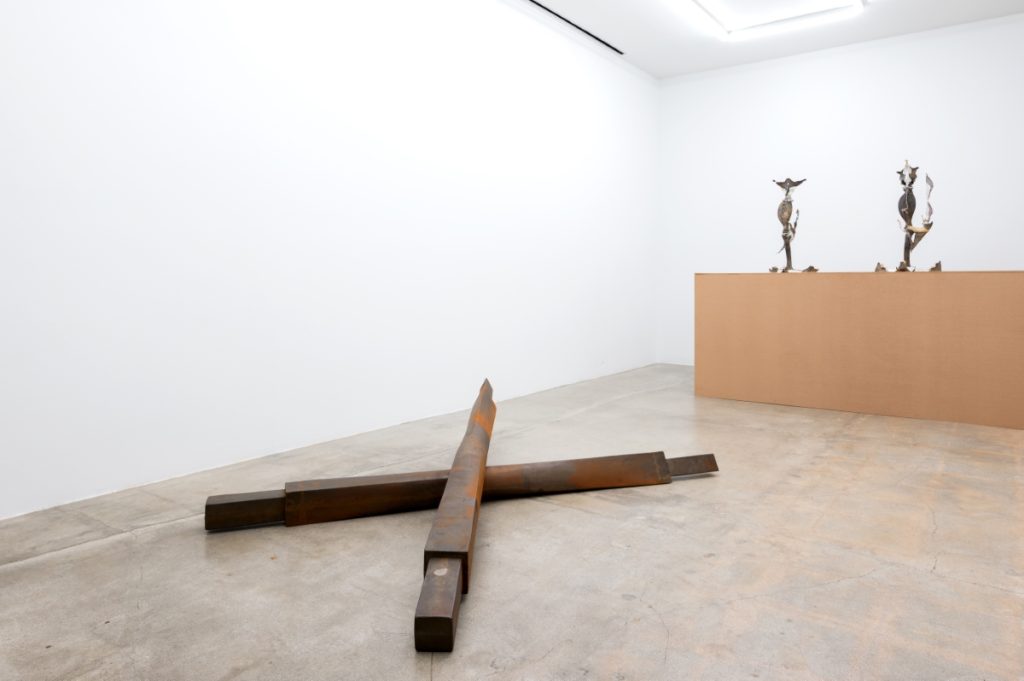
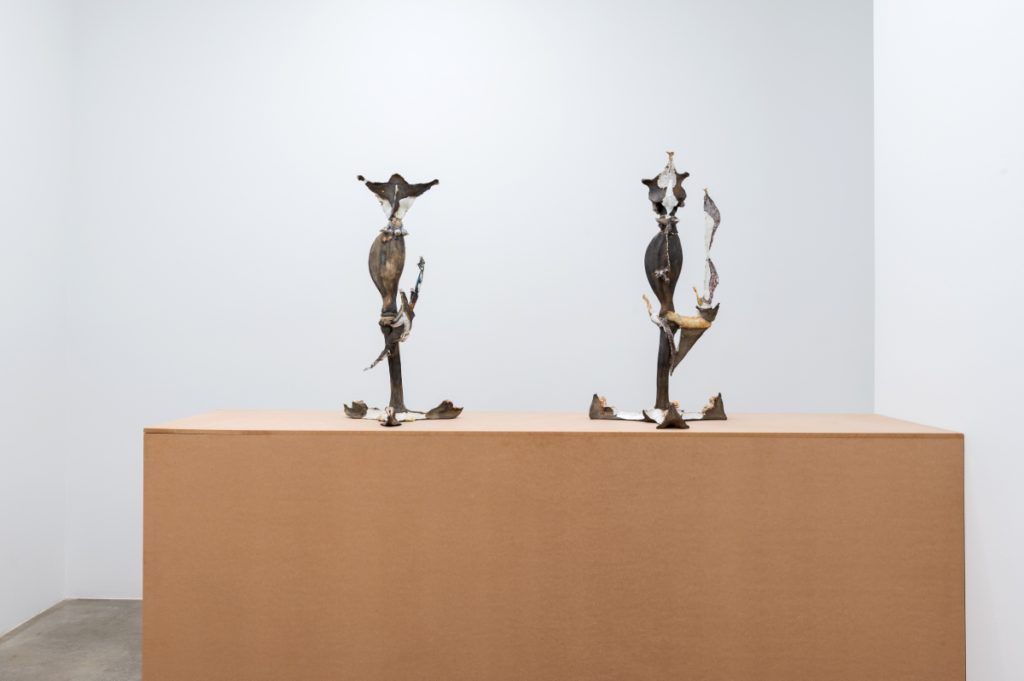
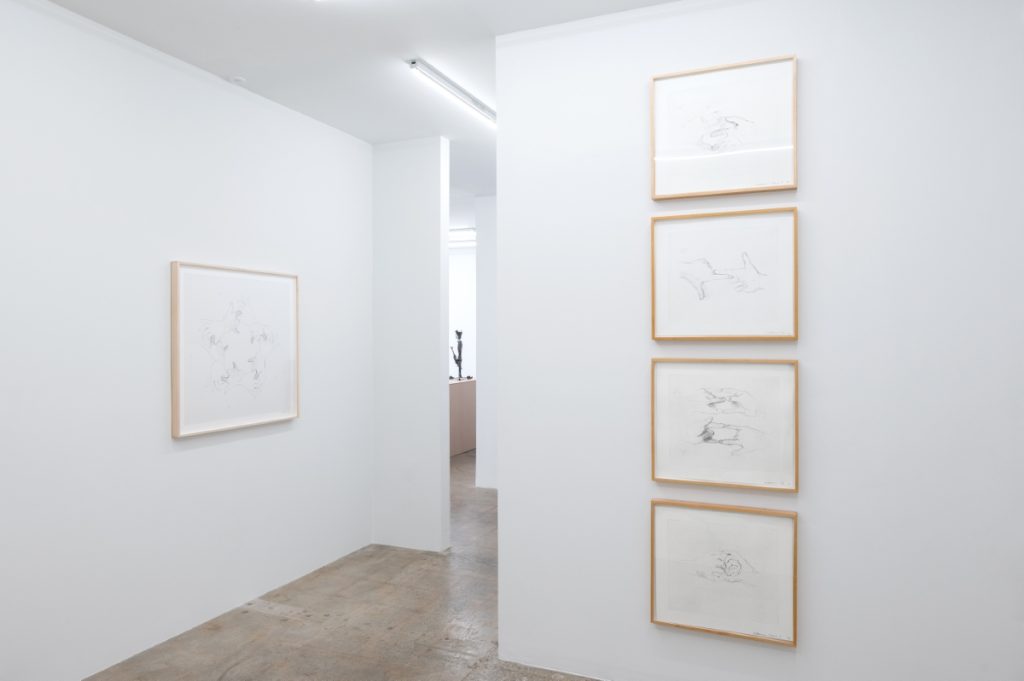

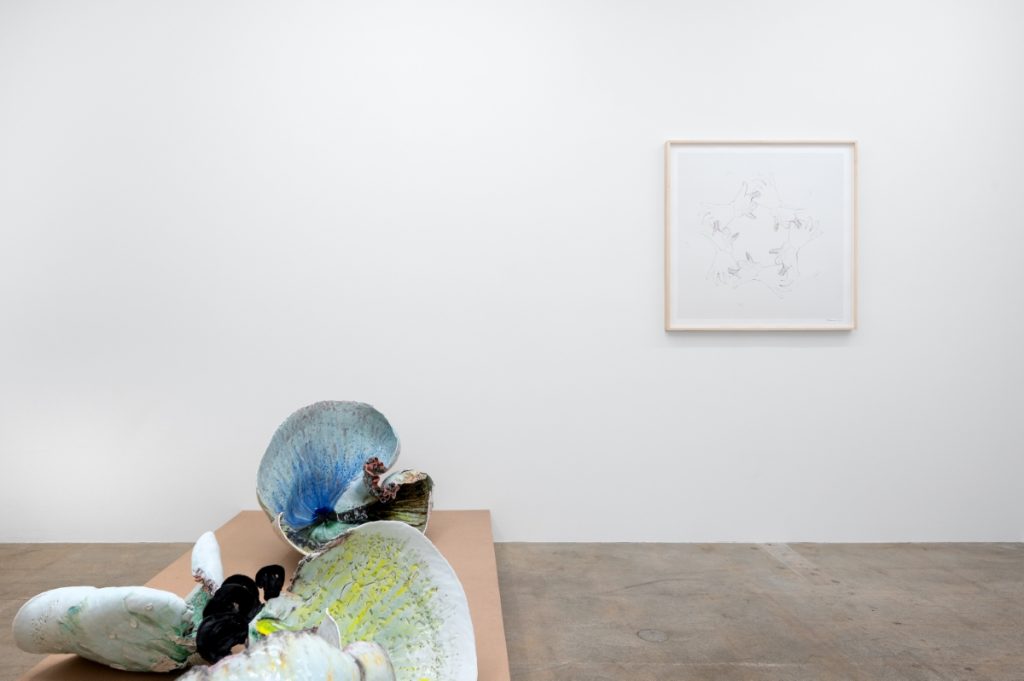
Kentaro Kawabata / Bruce Nauman is on view at Nonaka-Hill, Los Angeles
May 30 – July 20, 2024
“If you can manipulate clay and end up with art, you can manipulate yourself in it as well.”
Bruce Nauman
Nonaka-Hill presents a two-person exhibition of Kentaro Kawabata, a remarkable Japanese porcelain sculptor, alongside Bruce Nauman who, having built a diverse oeuvre in multi-media, is often cited as one of the most influential American artists of his generation. The exhibition curation was happenstantial at first, inspired by Kentaro Kawabata and Rodney Nonaka-Hill’s 2022 visit to the 59th edition of La Biennale di Venezia: The Milk of Dreams, followed by their viewing of Bruce Nauman: Contrapposto Studies at Pinault Collection’s Punta della Dogana. For Kawabata, who graduated in 2000 from Gifu, Japan’s Tajimi City Pottery Design and Technical Center and exhibiting initially in mostly ceramics contexts, this was his first exposure to a vaunted “art world” biennial and to the submersing impact of Nauman’s opus. In the two years since, Nonaka-Hill has contemplated the epiphanies experienced at these two exhibitions, comparing Nauman and Kawabata’s formal qualities, despite the apparent high contrast of the artists’ milieu. The exhibition seeks to collapse and coalesce that conceptual geography.
La Biennale di Venezia: The Milk of Dreams
“The Milk of Dreams”, curated by Cecilia Alemani, took its title from a children’s book by Leonora Carrington (1917–2011) in which the Surrealist artist describes a magical world where life is constantly re-envisioned through the prism of the imagination. Of her own birth, Carrington would say that she was the product of her mother’s encounter with a machine, suggesting the same bizarre union of human, animal, and mechanical that characterizes much of her work. With such a muse, Alemani’s exhibition delved into a broader world of artists living myriad freedoms and brimming with possibilities; multi-media works harmonized around such polarities as cultural, religious, gender identity and celebrated intersections of process, spiritual and erotic expression, making made a strong case for the fantastical imagination of artists who live and work outside of world’s commercial capitals and mainstream marketability. Though not present in the exhibition, Bruce Nauman’s 1967 neon sculpture, an icon of post-Minimalism, may have said it best: “The True Artist Helps the World by Revealing Mystic Truths”.
Bruce Nauman: Contrapposto Studies
Meanwhile, across the canal, “Bruce Nauman: Contrapposto Studies”, co-curated by Carlos Basualdo and Caroline Bourgeois, took as its starting point the artist’s career-long fascination with Contrapposto, the figurative art compositional scheme consistently employed since early Greek times which describes the diversion of a human body from taunt verticality and rigid symmetry settling into more relaxed angles at the hip and shoulder joints to impart a sense of naturalism. In 1969, Nauman, then a young avant-garde artist who was already described as Post-Minimal, endeavored without irony to demonstrate this Classical ideal within the emerging field of video performance art by inserting his organic body into geometric confines. To do so, he built two temporary walls facing each other twenty inches apart and lit its channel interior from above with intense light. He set a stationary Portapak on a tripod and, for the duration of the video tape, paced back and forth within the passageway walls, rotating his hips and shoulders from side to side, vacillating the arc of his vertical form. While perhaps not the artist’s stated intention, the resulting single channel work, and the important sculptural channel installations produced thereafter, can be contemplated as illusions of birth process and/or of heavenly ascension. Revisiting the Contrapposto subject some 50 years later, Nauman composed large scale projection walls to bathe his viewers in canyons of empyreal colored light. He engaged new video editing technologies to replicate, slice and shift his re-performed demonstration and obsessively committed observation. This concise formal exhibition, which edited out Nauman’s iconic neon, palindromic word-play works, and sculptural explorations of human body parts and animal taxidermy forms, celebrated one artist’s devotion to examination and re-examination of a formal device and the varying scales of important artistic production resulting therefrom.
Kentaro Kawabata / Bruce Nauman at Nonaka-Hill
Kentaro Kawabata shows a side of porcelain that we rarely see, the rips, the tears and the cracks while at the same time, delicate details, attenuated curlicues and the tiniest little beads, all placed at regular intervals, evidence of extreme artistic focus. The gallery’s central corridor presentation of Kawabata’s works playfully nods to traditional formats of symmetrical display for collections of fine porcelain plates and vessels or big game trophy heads (a nod to Nauman’s taxidermy works, not present in the exhibition). Kawabata’s characteristic Spoonsculptures are featured in varying scales and welcome all associations of artistic folly, or, alternatively, as testimony to the idea of spoon as as a life-sustaining object. The artist’s repetition of the spoon form is, for him, as normal of a “go-to” starting point for an artwork as a rectangle maybe for a painter. Elsewhere, Kawabata’s Bee’s Knees series (2002) stand in Contrapposto tripod-mechanized insect legs reminiscent of the visions of Leonora Carrington. Painting his porcelain with silver which oxidizes over time to a browned color, resembling dry animal or human bones; he achieves much of his color using pulverized or chipped stained glass which melts in the heat of the kiln and cascades in washes of brilliant flush over the white porcelain. This is especially evident in the Batista works (literally heart failures) from 2023/24 which fold into themselves on the floor in luminous heavings of gesture and color.
In his brief foray into ceramics, Bruce Nauman produced two useless vessels: Cup and Saucer Falling Over, 1965 and Cup Merging with its Saucer, also 1965. Soon, Nauman seemingly abandoned the permissiveness of clay, only to explore the plasticity of numerous other media (including words), while at the same time including plasticity as an artwork’s intrinsic subject. These spiral sculptural forms, which take cup vessels as their muse, presage later works which insist on diverting from rigid geometry and present also as useless; Skewed Tunnel and Trench in False Perspective (1981) presents as a large-scale sculpture, physically manifesting in classical materials the idea of a tunnel, turning in on itself like a snake eating its tail. If a viewer projects themself moving through Nauman’s miniature tunnel and trench, it’s a maddeningly endless loop, much like many of Nauman’s numerous entrapment art experiences. A selection of 1968/2006 Infrared Outtakes and Fingers and Holes (1996) where the artist’s own hands and face–neck, lips, eyeball–show us an economy of means, as do two late 1960s videos Flesh to White to Black to Flesh (1968) and Manipulating a Fluorescent Tube (1969) -enacting a process of self-transformation by connecting physical movement with inner processes–or lack thereof.
Kentaro Kawabata (b. 1976; Saitama, Japan). After graduating from the Tajimi City Pottery Design and Technical Center in 2000, Kawabata began winning awards for his work, including the Kamoda Shoji Award at the Mashiko Pottery Exhibition (2004) and the Paramita Museum Ceramic Award (2007). His work has been the subject of numerous solo and group exhibitions at prominent ceramic institutions, including “The Power of Decoration: A Viewpoint on Contemporary Kôgei (Studio Crafts)” at the National Museum of Modern Art’s Crafts Gallery (2009); “Phenomenon of Contemporary Ceramic” the Ibaraki Ceramic Art Museum (2014); Museum of Modern Ceramic Art, Gifu (2004, 2010). Selected recent solo exhibitions include: “Butterfly Joint”, Mendes Wood DM, São Paulo, Brazil (2023 ); “Yours Truly”, HIGH ART, Paris, France (2022); 凸凹 Bumpy, Nonaka-Hill, Los Angeles, CA (2021). Selected group exhibitions include: “an arena”, Nonaka-Hill with Barbati Gallery, Venice, Italy (2024); “100 Hooks”, Blunk Space, Point Reyes, CA (2023); “Room by Rook: Concepts, Themes, and Artists in the Rachofsky Collection”, The Warehouse Museum, Dallas, Texas (2023). Museums and Public Collections include: Gifu Contemporary Ceramics Museum, Gifu, Japan; Minneapolis Institute of Arts, Minneapolis, Minnesota; Mashiko Museum of Ceramic Art, Mashiko, Japan; Anadolu University, Eskişehir, Turkey; National Museum of Asian Art, Berlin, Germany; M+, Hong Kong.
Bruce Nauman (b. 1941; Fort Wayne, IN). Nauman received his B.S. from University of Wisconsin, Madison in 1964 and M.F.A. from University of California, Davis in 1966. Nauman has received several awards, including Frederick Kiesler Prize for Architecture and the Arts, Austria (2014); Golden Lion for Best National Participation, Venice Biennale (2009); Praemium Imperiale Prize for Visual Arts, Japan (2004); The Wexner Prize from Ohio State University(1994). Nauman has been subject to numerous international museum exhibitions, including Stedelijk Museum, Amsterdam (2021); Tate (2020); Museum of Modern Art MoMA PS1 (2019);Schaulager, Basel (2018); Fondation Cartier pour l’art contemporain, Paris (2015); Hamburger Bahnhof, Museum für Gegenwart, Berlin (2010); Museo Nacional Centro de Arte Reina Sofia,Madrid (1993-1994); Museum of Contemporary Art, Los Angeles (1994). Selected recent solo exhibitions include: “Bruce Nauman,” Tai Kwun Contemporary, Hong Kong (2024); “Bruce Nauman: Practice”, Konrad Fischer Galerie, Berlin, Germany (2022); “Bruce Nauman: Contrapposto Studies” Punta della Dogana, Venice, Italy (2022). Selected recent group exhibitions include: “The Body as Matter: Giacometti Nauman Picasso,” Gagosian, London, United Kingdom (2024); “L’uomo senza qualità: Gian Enzo Sperone collezionista, ”Museum of Modern and Contemporary Art of Trento and Rovereto (MART), Rovereto, Italy,(2023); “Gertrude Stein and Pablo Picasso,” Musée du Luxembourg, Paris, France (2023). Museums and Public Collections include: Art Institute of Chicago, Chicago, Illinois; Centre Georges Pompidou, Paris, France; Dallas Museum of Art, Dallas, Texas; Dia Art Foundation,New York, New York; Hirshhorn Museum and Sculpture Garden, Washington D.C.; Los Angeles.
Contact
gallery@nonaka-hill.com
Nonaka-Hill
720 N. Highland Ave.
Los Angeles, CA 90038
United States
Captions
- Bruce Nauman – Installation views © 2024 Bruce Nauman / Artists Rights Society (ARS), New York
- Kentaro Kawabata – Images courtesy of Kentaro Kawabata and Nonaka-Hill, Los Angeles



